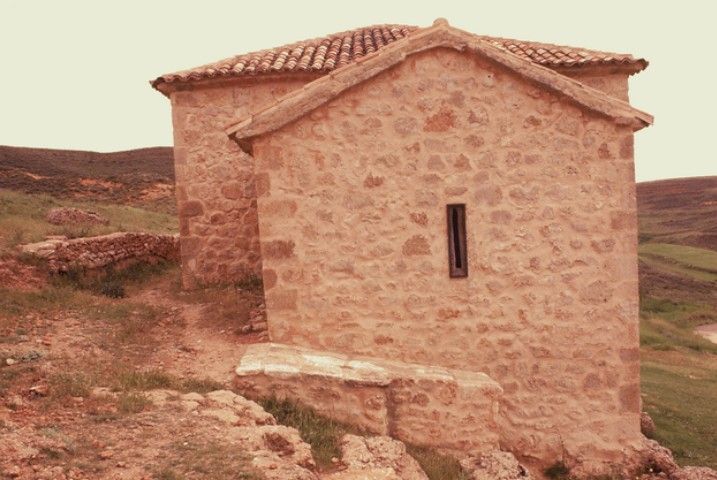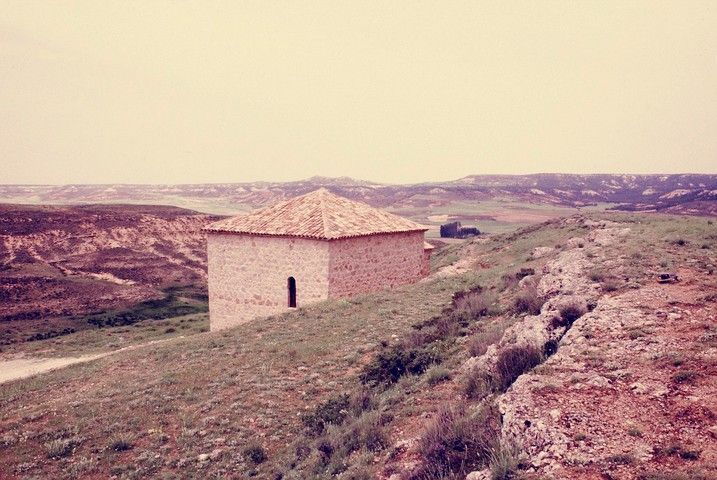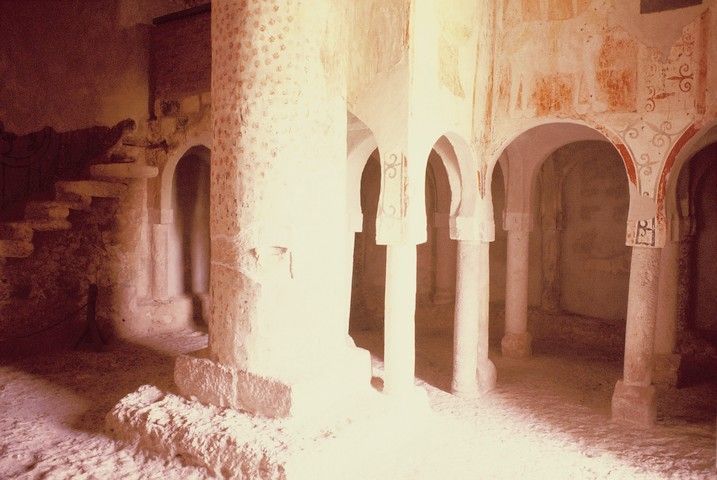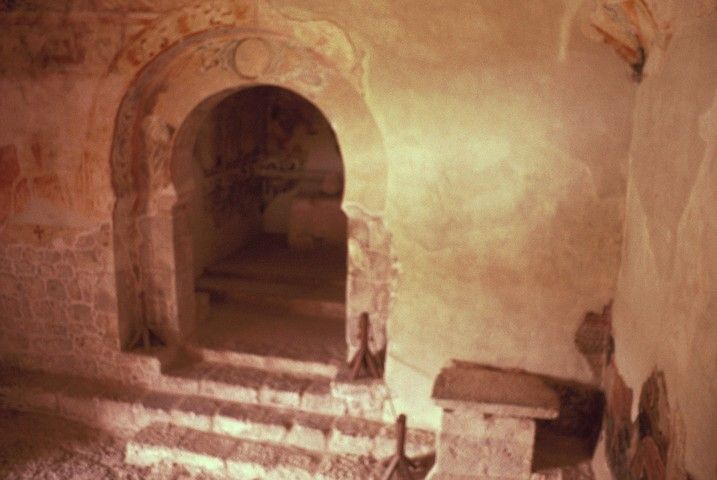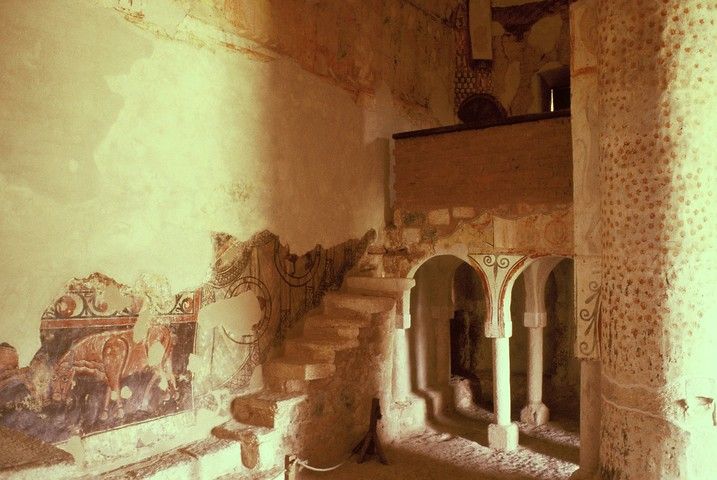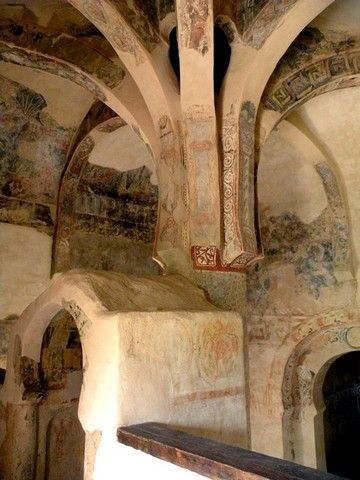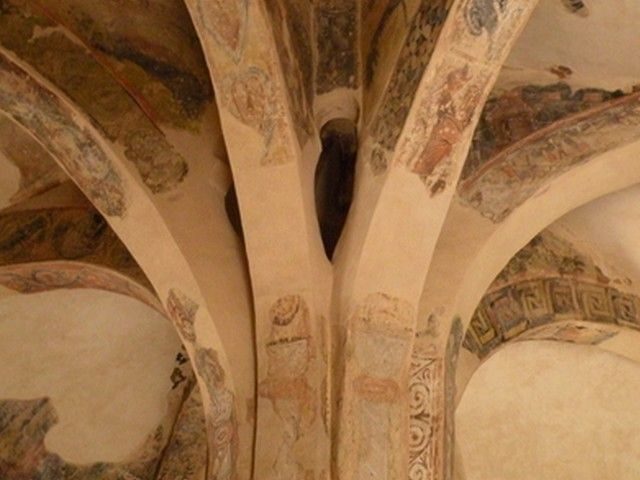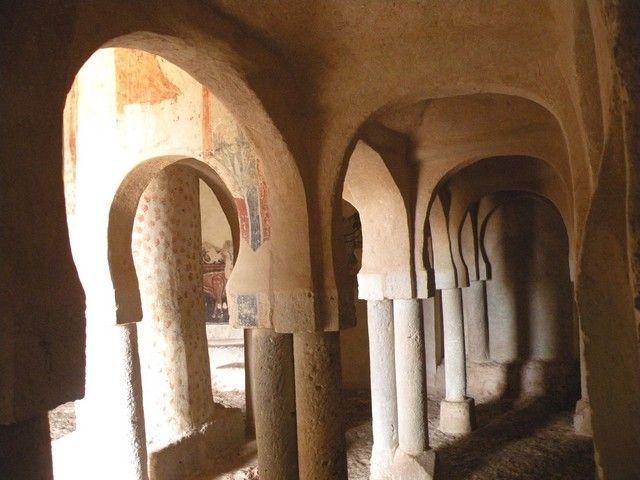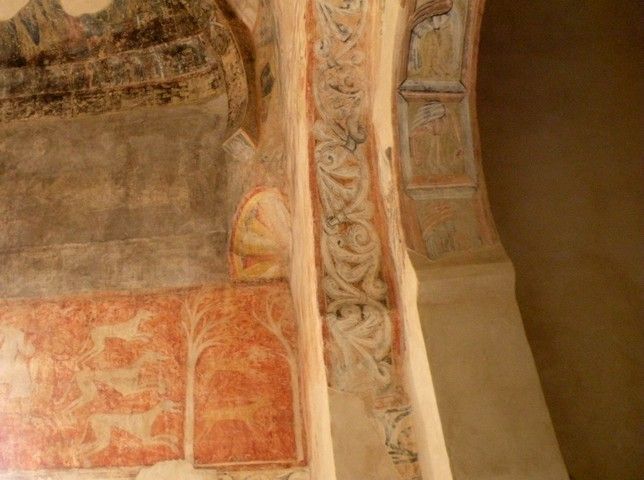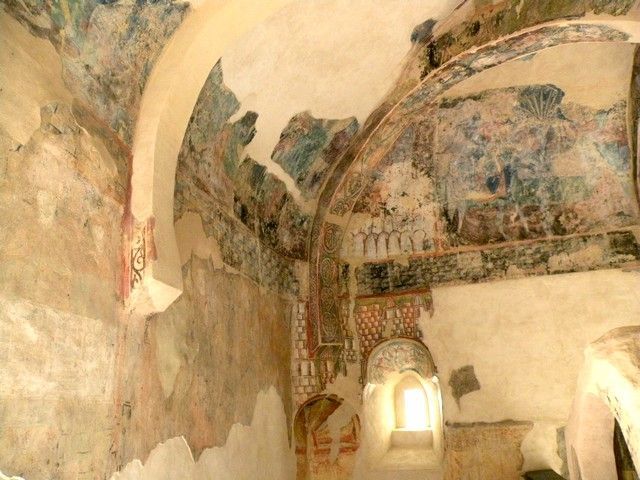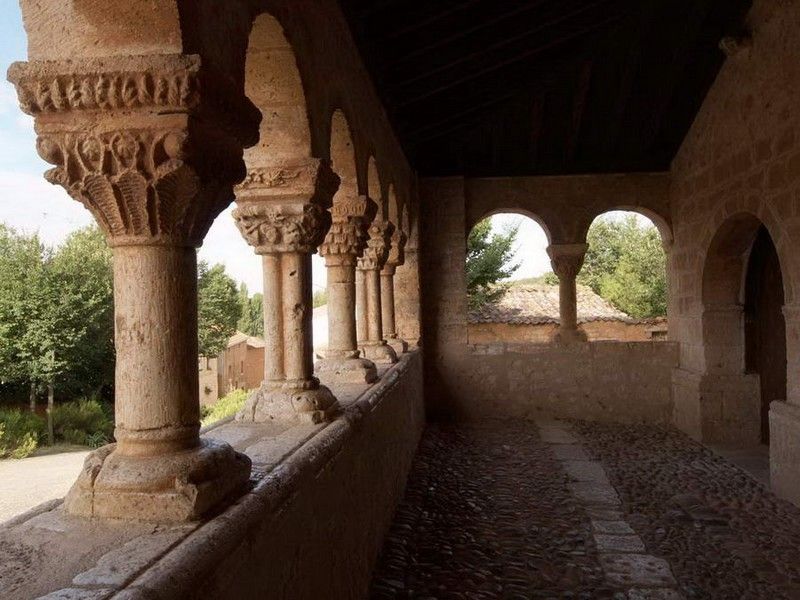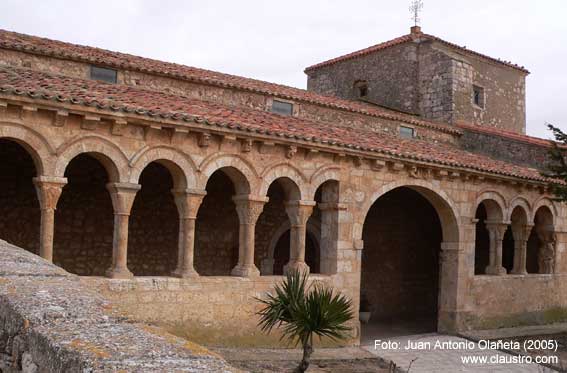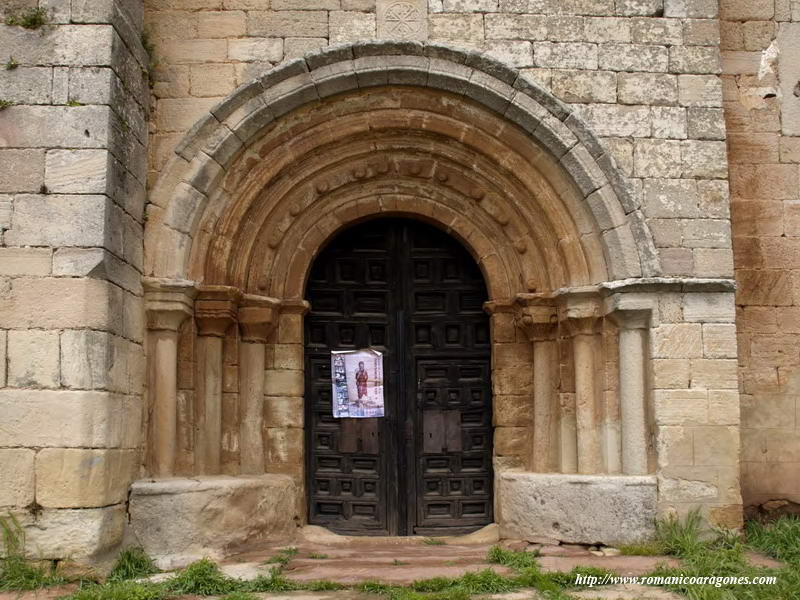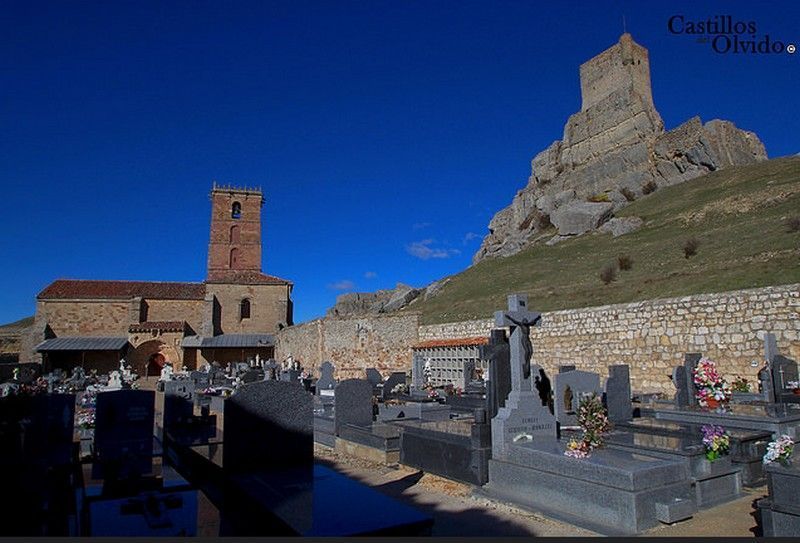SAN BAUDELIO DE BERLANGA

Previous notes
- A pesar de haber sido declarada Monumento Nacional en 1917, sus pinturas fueron vendidas a varios museos norteamericanos en 1922, aunque parte de ellas han vuelto al Museo del Prado en 1957.
- Debido a las especiales características del edificio y sus pinturas, ha existido una gran controversia respecto a su fecha de construcción, aunque en la actualidad es considerada generalmente como de finales del siglo XI.
- Todas las fotos de esta ficha y la primera línea de la galería fueron tomadas antes de la última restauración de San Baudelio, cuando se habían retirado gran parte de las pinturas originales que quedaban. Las de la segunda línea de la galería son actuales, con dichas pinturas restauradas.
Description
 doors, one in the northern wall with a double horse shoe arch extended 1/3 of its radius, and another one, round arch, facing west, both placed at different levels availing themselves from the uneven land. This nave has another cube attached to, smaller in its east side, covered with a gable roof. The church is built with thick walls upon a base of big ashlars, without any external decoration, nor eaves, modillions nor any other detail that might attract the attention in this small building that only has two horse shoe windows, very narrow and with interior embrasures, one in the apse and the other one higher on its west side of the northern face.
doors, one in the northern wall with a double horse shoe arch extended 1/3 of its radius, and another one, round arch, facing west, both placed at different levels availing themselves from the uneven land. This nave has another cube attached to, smaller in its east side, covered with a gable roof. The church is built with thick walls upon a base of big ashlars, without any external decoration, nor eaves, modillions nor any other detail that might attract the attention in this small building that only has two horse shoe windows, very narrow and with interior embrasures, one in the apse and the other one higher on its west side of the northern face. supposedly was the origin of the hermit life in that place. There is a second plan above this ensemble where there is a sort of a small raised chapel with access from the outside through the western door or, in the inside, through stairs attached to the southern side. However, the east half of the nave is plenty of light and communicates with the rectangular apse through five steps and a horse shoe arch. The apse is somewhat raised above the floor level of the nave, covered by a barrel vault that forms the second cube of the building. All of this is even more surprising for the remains of the paintings that have been preserved, most of them close to the date the church was built, that decorated practically all the inner spaces of the church until 1925.
supposedly was the origin of the hermit life in that place. There is a second plan above this ensemble where there is a sort of a small raised chapel with access from the outside through the western door or, in the inside, through stairs attached to the southern side. However, the east half of the nave is plenty of light and communicates with the rectangular apse through five steps and a horse shoe arch. The apse is somewhat raised above the floor level of the nave, covered by a barrel vault that forms the second cube of the building. All of this is even more surprising for the remains of the paintings that have been preserved, most of them close to the date the church was built, that decorated practically all the inner spaces of the church until 1925.
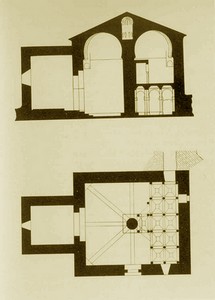 and ending in the apex and centres of the side of the
and ending in the apex and centres of the side of the 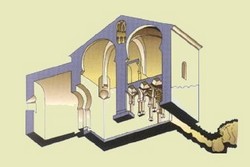 rectangle that forms the nave. It is a very unusual solution without any known precedents, of which we have only found another example of the same period in the chapel of Santa María de Peñalba in Arnedillo (La Rioja), although in that case with just four arches, and later in some constructions attributed to the Templars, like the church of La Vera Cruz in Segovia or the chapel of Nuestra Señora de Monsagro in Asturias. However, there we find very interesting similarities with other Mozarabic monuments, like the fact that the horizontal projection of the vault of San Baudelio is identical to each one of the apses of San Millán de Suso, but much larger, for which, maybe in this case, a central pillar was requiered. Another interesting similarity is that the arches that end up in corners, in order to keep the sensation of horse shoe arches, they lean upon overhangs with the shape of a quarter cylinder, similar to the fourths of stepped pyramid that are used for the same purpose in Santiago de Peñalba. We can also highlight the funny similarity with the small chapel of Santas Céntola y Elena that, in spite the big differences between them, they have in common the fact that they consist of only one nave and one apse, as well as a similar type of construction, the apses, that are Visigothic in both cases, rectangular, flat sanctuary and barrel vault, though in Siero it is a horse shoe one; the pew in stone along all the walls except in the chevet and, above all, the structure of the apses’ horse shoe arches and the northern door of San Baudelio, very similar to the one of the chevet of that chapel, all of them extended 1/3 of their radius, an extension produced through an impost that overhangs the arch generating the horse shoe shape. Characteristics that are more frequent in Visigothic than in Mozarabic art.
rectangle that forms the nave. It is a very unusual solution without any known precedents, of which we have only found another example of the same period in the chapel of Santa María de Peñalba in Arnedillo (La Rioja), although in that case with just four arches, and later in some constructions attributed to the Templars, like the church of La Vera Cruz in Segovia or the chapel of Nuestra Señora de Monsagro in Asturias. However, there we find very interesting similarities with other Mozarabic monuments, like the fact that the horizontal projection of the vault of San Baudelio is identical to each one of the apses of San Millán de Suso, but much larger, for which, maybe in this case, a central pillar was requiered. Another interesting similarity is that the arches that end up in corners, in order to keep the sensation of horse shoe arches, they lean upon overhangs with the shape of a quarter cylinder, similar to the fourths of stepped pyramid that are used for the same purpose in Santiago de Peñalba. We can also highlight the funny similarity with the small chapel of Santas Céntola y Elena that, in spite the big differences between them, they have in common the fact that they consist of only one nave and one apse, as well as a similar type of construction, the apses, that are Visigothic in both cases, rectangular, flat sanctuary and barrel vault, though in Siero it is a horse shoe one; the pew in stone along all the walls except in the chevet and, above all, the structure of the apses’ horse shoe arches and the northern door of San Baudelio, very similar to the one of the chevet of that chapel, all of them extended 1/3 of their radius, an extension produced through an impost that overhangs the arch generating the horse shoe shape. Characteristics that are more frequent in Visigothic than in Mozarabic art.But surprises are just about to start. Opposite the apse, as something also exclusive of this church, the western half of the nave is occupied by a set of three rows of six small columns each, that support very irregular horse shoe  arches. They are cylindrical upon cubic plinths, without bases but with some decoration in the joint with the plinth, and without a capital, although the conjunction of several arches upon each column forms something similar to a keel moulding. This ensemble produces the sensation of forming a small mosque of less than two meters high, without any precedent in Spanish Pre Romanesque art, supports small cloister vaults between the arches (in this case the vaults have four stretches), a second plan that takes up a great part of the western half of the church (the only precedent that we know of is the gallery in Santa Cristina de Lena. However, in San Baudelio the interpretation of this raised space, that also has a balustrade, partly rebuilt during the last restorations, is more complex than in the case of the Asturian church, as its inner space, besides the elements we find in it, including the inner staircase attached to the southern side, this one has a door to the outside and a sort of oratory, also covered by a barrel vault, with access through a small horse shoe arch of just 1.8m high, that goes on from the choir to the central pillar, generating a small peculiar chapel within the church, also facing east, as the apse does. Neither there are precedents in Spanish Pre Romanesque art of raised chapels of this kind, for which several interpretations have come up, since the one supporting it was an area for laymen to the one that holds it was a tabernacle for private cult ceremonies, but so far we are not certain as what its real purpose was.
arches. They are cylindrical upon cubic plinths, without bases but with some decoration in the joint with the plinth, and without a capital, although the conjunction of several arches upon each column forms something similar to a keel moulding. This ensemble produces the sensation of forming a small mosque of less than two meters high, without any precedent in Spanish Pre Romanesque art, supports small cloister vaults between the arches (in this case the vaults have four stretches), a second plan that takes up a great part of the western half of the church (the only precedent that we know of is the gallery in Santa Cristina de Lena. However, in San Baudelio the interpretation of this raised space, that also has a balustrade, partly rebuilt during the last restorations, is more complex than in the case of the Asturian church, as its inner space, besides the elements we find in it, including the inner staircase attached to the southern side, this one has a door to the outside and a sort of oratory, also covered by a barrel vault, with access through a small horse shoe arch of just 1.8m high, that goes on from the choir to the central pillar, generating a small peculiar chapel within the church, also facing east, as the apse does. Neither there are precedents in Spanish Pre Romanesque art of raised chapels of this kind, for which several interpretations have come up, since the one supporting it was an area for laymen to the one that holds it was a tabernacle for private cult ceremonies, but so far we are not certain as what its real purpose was.
Even more surprising is a small almost inaccessible compartment in the  central pillar, just above the beginning of the eight arches that support the vault, availing themselves of the space that the arches produce in a zone where the pillar does not have supporting functions any longer. The result is a space of a cylindrical shape of approximately one meter diameter by two meters high that communicates with the outside through eight small horse shoe windows of around 24cm high placed between the big arches of the central support, that let watch the interior covered by a caliphal cupola, carefully decorated, similar to those in the mosque of Córdoba and Cristo de La Luz in Toledo, formed by a double framework with six ribs in horse shoe arch and two others that cross in the centre. Neither there are precedents of a structure of this kind, although a relation may be established with the compartments above the chevets of some Visigothic and Asturian churches and a protection function -quite dubious as it is very easy to get there- of objects for the cult. It seems more related with the oriental tradition preserved by the Islamic culture of decorating with great care some poorly visible spaces but with great religious meaning, for which it would probably have been dedicated to preserve the remains of San Baudelio.
central pillar, just above the beginning of the eight arches that support the vault, availing themselves of the space that the arches produce in a zone where the pillar does not have supporting functions any longer. The result is a space of a cylindrical shape of approximately one meter diameter by two meters high that communicates with the outside through eight small horse shoe windows of around 24cm high placed between the big arches of the central support, that let watch the interior covered by a caliphal cupola, carefully decorated, similar to those in the mosque of Córdoba and Cristo de La Luz in Toledo, formed by a double framework with six ribs in horse shoe arch and two others that cross in the centre. Neither there are precedents of a structure of this kind, although a relation may be established with the compartments above the chevets of some Visigothic and Asturian churches and a protection function -quite dubious as it is very easy to get there- of objects for the cult. It seems more related with the oriental tradition preserved by the Islamic culture of decorating with great care some poorly visible spaces but with great religious meaning, for which it would probably have been dedicated to preserve the remains of San Baudelio.
Special mention, but also of a difficult interpretation, deserves the set of paintings that covered all interior surfaces, distributed in three very different groups, both, for its characteristics and for its location in the church The first one formed by a series of animals made with a very primitive technique, the second one by a set of a hunting scene and the last one by a series of Romanesque paintings of religious subjects. Shortly we shall dedicate a monographic study on this subject.
Conclusions
Reconsidering what we have seen so far, we reach to the conlusion that, in spite that its apse and horse shoe arches could be Visigothic, it is unquestionable that we are in front of a church of Mozarabic style, with very special characteristics as it is the only one formed by one nave and one apse only, with the main door in the northern side and with two levels in its interior. Besides, there is only one other church of that period covered with only one vault supported by arches that lean on a central pillar. It is also the Mozarabic construction located most to the south within the Christian territory, but at the same time it meets more characteristics of the Islamic art and we believe it is important to highlight that it is a building with a very complicated structure that demanded its builders an important technical expertise.
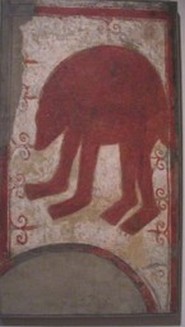 The major problem we had to establish the dating of of San Baudelio lies in the likely incompatibility between the characteristics of the monument and its building date, as it is usually based in that the building must have taken place later than the definite Reconquest of the area in 1060 by Fernando the First. That is why it is generally accepted that it had been built during the consolidation of the zone of the Duero river after the conquest of Toledo by Alfonso the Sixth in 1085. The problem is the deep Arabism of the monument, at times when the reform of Cluniac and Romanesque art had already been introduced in Castilla and León; the Mozarabic lithurgy had been officially left behind since 1071 and new churches in the new style were beginning to be built throughout the kingdom, like San Frutos de Duratón, the first Romanesque church of San Isidoro in León, of which only the crypt is preserved, and the church of San Miguel in the near San Esteban de Gormaz, among many others. We will also see in the corresponding annex that a similar thing happens with part of the paintings that existed in its interior. Due to these important contradictions, in this so special case we think there is not enough information so as to confirm such a late building date for San Baudelio and part of its paintings, although we think that the analysis of the historical situation of its environment and of its time are basic for dating a monument. Therefore it seems advisable to study from a different perspective its relation with the artistic and historical environment so as to try to revise a date that is so unappropiate considering the characteristics of the buildings.
The major problem we had to establish the dating of of San Baudelio lies in the likely incompatibility between the characteristics of the monument and its building date, as it is usually based in that the building must have taken place later than the definite Reconquest of the area in 1060 by Fernando the First. That is why it is generally accepted that it had been built during the consolidation of the zone of the Duero river after the conquest of Toledo by Alfonso the Sixth in 1085. The problem is the deep Arabism of the monument, at times when the reform of Cluniac and Romanesque art had already been introduced in Castilla and León; the Mozarabic lithurgy had been officially left behind since 1071 and new churches in the new style were beginning to be built throughout the kingdom, like San Frutos de Duratón, the first Romanesque church of San Isidoro in León, of which only the crypt is preserved, and the church of San Miguel in the near San Esteban de Gormaz, among many others. We will also see in the corresponding annex that a similar thing happens with part of the paintings that existed in its interior. Due to these important contradictions, in this so special case we think there is not enough information so as to confirm such a late building date for San Baudelio and part of its paintings, although we think that the analysis of the historical situation of its environment and of its time are basic for dating a monument. Therefore it seems advisable to study from a different perspective its relation with the artistic and historical environment so as to try to revise a date that is so unappropiate considering the characteristics of the buildings.
If we accept that San Baudelio de Berlanga is a Mozarabic church, it makes it difficult to understand that it had ben built more than a hundred years after the last known examples of that style. Besides, if we analyse the church-state relation in the second half of the 11th century, it does not seem that a monastery of its size and, specially, of its complexity, could have been built during a period when both, the monarchy of Castille and Navarra were supporting the Gregorian and Cluniac reform, to the point that the first bishops of Osma and Sigüenza, that competed for our monastery, came from Cluny, so they would not have approved the building of a church of these characteristics in their dioceses, after having forbidden the use of the Mozarabic rite in both kingdoms.
We think it is more reasonable to set for this monastery an historical tour, similar to many others of the same period that developed in far away places around a cave and near a  course of water, created generally along the 6th and 7th centuries by groups of hermits that went to retreat to this kind of environments, and that in many cases they kept themselves active and ignored during the Arab domination, generating small centres of monastic life around a church that was being built in this new phase, like San Millán de Suso, Santiago de Peñalba, San Frutos de Duratón and so many others.
course of water, created generally along the 6th and 7th centuries by groups of hermits that went to retreat to this kind of environments, and that in many cases they kept themselves active and ignored during the Arab domination, generating small centres of monastic life around a church that was being built in this new phase, like San Millán de Suso, Santiago de Peñalba, San Frutos de Duratón and so many others.
Along this line, which we may consider as the most likely one also in this case, that even in Visigothic times, a group of hermits would retreat to a remote cave in any inhabited zone and would create there a monastery in honour of San Baudelio, martyr of Nîmes, whose worship was by then very spread out in Spain. As in other cases already mentioned, it is most likely that until the Arab Conquest the community had developed very little and kept a kind of cenobitic life without raising important buildings, what let them keep the status during the Arab domination, evolving from there into a monastic life and building the monastery when the repopulation started. But in this case we find ourselves with a very peculiar situation because it is a zone that was conquered and lost several times by the Christians along the 10th and 11th centuries. In fact, it was populated for the first time in 912 during the reign of García the Fisrt of León, and since then until the definite Reconquest by Fernando the First in 1060, had changed hands several times staying under Christian domination for long although unsafe periods.
From our point of view, given the special characteristics of San Baudelio, it would be interesting to analyse in depth the possiblity that it was  built during one of those changes of dominion, maybe in the repopulation of 912, during a great Mozarabic migration to the Christian territories, what explains the technical quality and great influence of Islamic art in the design of such a meaningful building. This dating solves all the stylistic and historical problems of this constructrion except the existence of double horse shoe arches that are not seen in any other Pre Romanesque monument and that are frequent in rounded arches in Romanesque art. Besides, it also extends the likely dating periods of its different series of paintings, wheras it only raises the big question about how could it have survived without being pulled down during the consecutive invasions in times of Abderrahmán the Third, Alhaquem the Second, and above all, the dreadful campaigns of Almanzor. The answer could be in the lack of news about the monastery in those times. Maybe for its location an for its limited importance it was little known and could thus be saved. Quite the opposite of what has happened with the big centres of Christian worship like San Millán de La Cogolla or Compostela.
built during one of those changes of dominion, maybe in the repopulation of 912, during a great Mozarabic migration to the Christian territories, what explains the technical quality and great influence of Islamic art in the design of such a meaningful building. This dating solves all the stylistic and historical problems of this constructrion except the existence of double horse shoe arches that are not seen in any other Pre Romanesque monument and that are frequent in rounded arches in Romanesque art. Besides, it also extends the likely dating periods of its different series of paintings, wheras it only raises the big question about how could it have survived without being pulled down during the consecutive invasions in times of Abderrahmán the Third, Alhaquem the Second, and above all, the dreadful campaigns of Almanzor. The answer could be in the lack of news about the monastery in those times. Maybe for its location an for its limited importance it was little known and could thus be saved. Quite the opposite of what has happened with the big centres of Christian worship like San Millán de La Cogolla or Compostela.
Anyway, independently of the opinion about its origin, it is a monument of great originality and beauty, that for its characteristics it is another clear exponent of eclecticism in Spanish art in those times and we consider it mandatory to pay a visit as a basic element for the knoweledge of Spanish Pre Romanesque art, with the added interest of the appealing questions it contains about its possible dating. From our end, in relation with these subjects we offer our forum to anybody willing to suggest any idea or recommendation about the creation or the history of this monastery.
Other interesting information
Access: On leaving Soria, take SO-100 to Berlanga de Duero. In Berlanga, take SO-152 until Caltojar. Before getting there, take a detour at your right by SO-P-4153 for 790m until San Baudelio. Total distance, 59.6 Km.
Coordenadas GPS: 41º 25′ 5,72″N 2º 47′ 24,49″W.
Information telephone: Tlf.: 975.22.13.97 (Museo Numantino) 42367 Casillas de Berlanga (Soria)
Visiting hours: From April 1 to September 30: 10.00 to 14.00 and from 16.00 to 20.00.
From October 1 to March 31: from 10.00 to 14.00 and from 16.00 to 18.00
Last access 15 min before.
Sunday and holidays open only in the morning, Monday and Tuesday CLOSED
Tickets: 0.60?. Saturdays and Sundays free.
Bibliography
Imagen del Arte Mozárabe; José Fernández Arenas
SUMMA ARTIS: Tomo VIII y XXII
Historia de España de Menéndez Pidal: Tomos VI y VII*
L’Art Preroman Hispanique – L’Art Mozarabe: ZODIAQUE
San Baudelio de Berlanga: Agustín Escolano Benito
Portals
Las Edades del Hombre
Casillas de Berlanga – San Baudelio
Ermita de San Baudelio
San Baudelio de Berlanga
San Baudelio de Berlanga
San Baudelio de Berlanga: La reposición de las pinturas murales de la ‘palmera’











